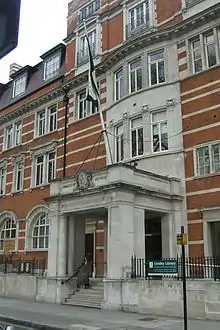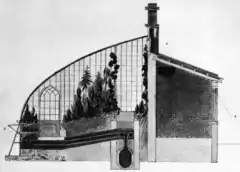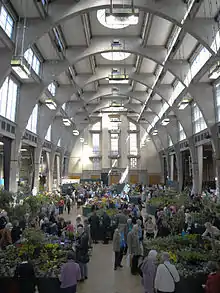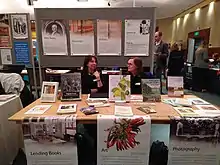Royal Horticultural Society
The Royal Horticultural Society (RHS), founded in 1804 as the Horticultural Society of London,[1][2] is the UK's leading gardening charity.[3][4][1]
 | |
| Abbreviation | RHS |
|---|---|
| Formation | 7 March 1804 (as Horticultural Society of London) |
| Type | Registered charity |
| Purpose | Promote gardening and horticulture |
| Headquarters | London, SW1 |
Region served | United Kingdom |
Membership | 414,699 (2013)[1] |
President | Keith Weed |
Budget | 2013/14 income: £71.94m[1] |
| Website | www.rhs.org.uk |

The RHS promotes horticulture through its four, soon to be five, gardens at Wisley, Hyde Hall (Essex), Harlow Carr (Yorkshire), Rosemoor (Devon) and Bridgewater (Greater Manchester); flower shows including the Chelsea Flower Show, Hampton Court Palace Flower Show, Tatton Park Flower Show and Cardiff Flower Show; community gardening schemes; Britain in Bloom and a vast educational programme. It also supports training for professional and amateur gardeners. The current president is Keith Weed and the current director general is Sue Biggs CBE.
History
Founders
The creation of a British horticultural society was suggested by John Wedgwood (son of Josiah Wedgwood) in 1800. His aims were fairly modest: he wanted to hold regular meetings, allowing the society's members the opportunity to present papers on their horticultural activities and discoveries, to encourage discussion of them, and to publish the results. The society would also award prizes for gardening achievements.
Wedgwood discussed the idea with his friends, but it was four years before the first meeting, of seven men, took place, on 7 March 1804 at Hatchards bookshop in Piccadilly, London. Wedgwood was chairman; also present were William Townsend Aiton (successor to his father, William Aiton, as Superintendent of Kew Gardens), Sir Joseph Banks (President of the Royal Society), James Dickson (a nurseryman), William Forsyth (Superintendent of the gardens of St. James's Palace and Kensington Palace), Charles Francis Greville (a Lord of the Admiralty) and Richard Anthony Salisbury, who became the Secretary of the new society.[5]
Banks proposed his friend Thomas Andrew Knight for membership. The proposal was accepted, despite Knight's ongoing feud with Forsyth over a plaster for healing tree wounds which Forsyth was developing. Knight was president of the society from 1811–1838, and developed the society's aims and objectives to include a programme of practical research into fruit-breeding.
Membership
In 2009, more than 363,000 people were members of the society, and the number increased to more than 414,000 in 2013[1] and to 525,105 by 2019.[6] Membership and fellowship of the society were previously decided by election, but are now by financial contribution. Fellowship may be secured through a "suggested" £5,000 donation each year.[7][8]
Members and Fellows of the Royal Horticultural Society are entitled to use the post-nominal letters MRHS[9] and FRHS, respectively.[10]
| Financial year | Number of members |
|---|---|
| 2013/14[1] | 414,699 |
| 2014/15[11] | 428,472 |
| 2015/16[12] | 448,977 |
| 2016/17[13] | 472,157 |
| 2017/18[14] | 490,205 |
| 2018/19[15] | 502,666 |
| 2019/20[6] | 525,105 |
Royal Horticultural Society gardens

The Royal Horticultural Society's four major gardens in England are: Wisley Garden, near Wisley in Surrey; Rosemoor Garden in Devon; Hyde Hall in Essex and Harlow Carr in Harrogate, North Yorkshire.
The society's first garden was in Kensington, from 1818 to 1822. In 1820 the society leased some of Hugh Ronalds' nursery ground at Little Ealing to set up an experimental garden,[16] but the next year part of the Duke of Devonshire's estate at Chiswick was obtained. In 1823 it employed Joseph Paxton there. From 1827 the society held fêtes at the Chiswick garden, and from 1833, shows with competitive classes for flowers and vegetables. In 1861 the RHS (as it had now become) developed a new garden at South Kensington on land leased from the Royal Commission for the Exhibition of 1851 (the Science Museum, Imperial College and the Royal College of Music now occupy the site), but it was closed in 1882.[17] The Chiswick garden was maintained until 1903–1904, by which time Sir Thomas Hanbury had bought the garden at Wisley and presented it to the RHS.
RHS Garden Wisley is thus the society's oldest garden. Rosemoor came next, presented by Lady Anne Berry in 1988. Hyde Hall was given to the RHS in 1993 by its owners Dick and Helen Robinson. Dick Robinson was also the owner of the Harry Smith Collection which was based at Hyde Hall. The most recent addition is Harlow Carr, acquired by the merger of the Northern Horticultural Society with the RHS in 2001. It had been the Northern Horticultural Society's trial ground and display garden since they bought it in 1949. In 2013, more than 1.63 million people visited the four gardens.[1]
In 2015, the RHS announced plans for a fifth garden at Worsley New Hall, Greater Manchester, under the name RHS Garden Bridgewater.[18]
Royal Horticultural Society shows

The RHS is well known for its annual flower shows which take place across the UK. The most famous of these shows is the RHS Chelsea Flower Show, visited by people from across world. This is followed by the Hampton Court Palace Flower Show (which the RHS took over in 1993) and RHS Tatton Park Flower Show in Cheshire (since 1999).[19]
The most recent addition to the RHS shows line-up is the RHS Show Cardiff, held at Cardiff Castle since 2005.[20] The society is also closely involved with the spring and autumn shows at Malvern, Worcestershire, and with BBC Gardeners' World Live held annually at the Birmingham National Exhibition Centre.
Royal Horticultural Society libraries
The RHS is custodian of the Lindley Library, housed within its headquarters at 80 Vincent Square, London, and in branches at each of its four gardens. The library is based upon the book collection of John Lindley.[5]
The RHS Herbarium has its own image library (collection) consisting of more than 3,300 original watercolours, approximately 30,000 colour slides and a rapidly increasing number of digital images. Although most of the images have been supplied by photographers commissioned by the RHS, the archive includes a substantial number of slides from the Harry Smith Collection and Plant Heritage National Plant Collection holders.[21]
The Garden Library at Wisley Garden is open to visitors to the Garden.[22]
Britain in Bloom
In 2002, the RHS took over the administration of the Britain in Bloom competition from the Tidy Britain Group (formerly and subsequently Keep Britain Tidy).[23] In 2010, The society launched 'It's your neighbourhood', a campaign to encourage people to get involved in horticulture for the benefit of their community. In 2014, the 'Britain in Bloom' celebrates its 50th anniversary.[23]
Education and training

The RHS runs formal courses for professional and amateur gardeners and horticulturalists and also validates qualifications gained elsewhere (e.g. at Kew Botanic Gardens).[24]
The RHS Level 1 Award in Practical Horticulture aims to develop essential horticultural skills and to provide a foundation for further RHS practical qualifications at Levels 2 and 3. It is aimed at anyone who has an interest in plants and gardening.[24]
Level 2 qualifications provide a basis for entry into professional horticulture, support career development for existing horticultural workers or can provide a foundation for further learning or training. There are separate theoretical- and practical-based qualifications at this Level and the RHS Level 2 Diploma in the Principles and Practices of Horticulture combines the theoretical- and practical-based qualifications.[24][3]
Level 3 qualifications allow specialisation in the candidate's area of interest. They can offer proficiency for those looking for employment in horticulture, they can support further career and professional development for those already working in the field, or they can provide a basis for continued learning or training. As for Level 2, there are theoretical- and practical-based qualifications at Level 3 and a Diploma that combines both.[24]
The Master of Horticulture (RHS) Award is the society's most prestigious professional horticultural qualification. It is of degree level and it is intended for horticultural professionals. The course allows for flexible study over a period of three years or more.[24]
The RHS Campaign for School Gardening provides online inspiration, resources and advice to its members. With the help of teachers, volunteers and other school-gardening champions, they support millions of students in the UK, giving them the opportunity to grow plants, food and develop life skills.[1]
Medals and awards
People
The society honours certain persons with the Victoria Medal of Honour who are deemed by its Council to be deserving of special recognition in the field of horticulture. Other medals issued by the society include the Banksian, Knightian and Lindley medals, named after early officers of the society. It awards Gold, Silver-gilt, Silver and Bronze medals to exhibitors at its Flower Shows.[25]
The Veitch Memorial Medal, named after James Veitch, is awarded annually to persons of any nationality who have made an outstanding contribution to the advancement and improvement of the science and practice of horticulture.
Other awards bestowed by the society include the Associate of Honour and the Honorary Fellowship.[26]
Plants
The Award of Garden Merit, or AGM, is the principal award made to garden plants by the society after a period of assessment by the appropriate committees of the society. Awards are made annually after plant trials.
Older books may contain references to the following awards, which were based mainly on flower quality[27] (but which are not referred to in current (2014) RHS websites and reports):
- PC: Preliminary Certificate
- HC: Highly Commended
- AM: Award of Merit (not the same as the AGM)
- FCC: First Class Certificate (once a very prestigious award)
Publications
Journals
The society published its proceedings as the Transactions of the Horticultural Society of London from 1807 to 1848. The society has also published a journal since 1846. Initially known as the Journal of the Horticultural Society of London (1846–1855), then Proceedings of the Horticultural Society of London (1859–1860) and Proceedings of the Royal Horticultural Society (1861–1869). This was continued as Journal of the Royal Horticultural Society (1866–1975).[2]
Since 1975 it has been entitled The Garden and is currently a monthly publication. The RHS also publishes both The Plantsman and The Orchid Review four times a year, and Hanburyana, an annual publication dedicated to horticultural taxonomy since 2006.[2][28][29]
Registers and encyclopedias
Since the establishment of International Registration Authorities for plants in 1955 the RHS has acted as Registrar for certain groups of cultivated plants. It is now Registrar for nine categories – conifers, clematis, daffodils, dahlias, delphiniums, dianthus, lilies, orchids and rhododendrons. It publishes The International Orchid Register, the central listing of orchid hybrids. It published Encyclopedia of Conifers in 2012.
Books
The RHS publishes many horticulture and gardening books, including:
- Ingram, David S.; Vince-Prue, Daphne; Gregory, Peter J., eds. (2008). Science and the garden the scientific basis of horticultural practice (2nd ed.). Oxford: Blackwell. ISBN 9781444360356.
- Huxley, Anthony; Griffiths, Mark; Levy, Margot (1992) [1st ed. Frederick Chittenden and William Stearn. Oxford University Press 1951. 2nd ed. P.M. Synge (ed.) Oxford 1956]. The New Royal Horticultural Society Dictionary of Gardening (4 vols.). London: Macmillan. ISBN 978-0333474945.
Presidents
- Horticultural Society of London (1804–1861)
- 1811–1838 : Thomas Andrew Knight (1st President)
- 1838–1858 : William Cavendish, 6th Duke of Devonshire
- 1858–1861 : Albert, Prince Consort[30]
- Royal Horticultural Society (1861-)
- 1862–1883 : Duke of Buccleuch [31]
- 1884–1885 : Sir Benjamin Thomas Brandreth-Gibbs
- 1885–1913 : Sir Trevor Lawrence[32]
- 1913–1919 : Francis Grenfell, 1st Baron Grenfell[33]
- 1919–1928 : Amelius Lockwood, 1st Baron Lambourne [34]
- 1928–1931 : Gerald Loder, 1st Baron Wakehurst [35](11th President)
- 1931–1953 : Henry McLaren, 2nd Baron Aberconway [36]
- 1953–1961 : Sir David Bowes-Lyon [37]
- 1961–1984 : Charles McLaren, 3rd Baron Aberconway [38]
- 1984–1994 : Robin A.E. Herbert [39]
- 1994–2001 : Sir Simon Hornby [40]
- 2001–2006 : Sir Richard Carew-Pole [41]
- 2006–2008 : Peter N. Buckley [42]
- 2009–2010 : Giles Coode-Adams [43]
- 2010–2013 : Elizabeth Banks [44]
- 2013–2020 : Sir Nicholas Bacon, Bt
- 2020–present : Keith Weed [45]
See also
- Arlow Stout, a pioneer in the hybridization of daylilies, honorary life fellow of RHS
- Lindley Hall, exhibition hall owned by the RHS and located next to their head office in London
- Robert Allen Rolfe, the founder of the magazine The Orchid Review
References
- "Annual Review 2013/2014". RHS. Retrieved 24 August 2014.
- SSP 2016.
- "RHS Level 2 Certificate in the Principles of Horticulture". learningwithexperts.com. Retrieved 25 February 2018.
- "RHS Appoints New Head of Science, Dr Alistair Griffiths". prolandscapermagazine.com. 3 May 2013. Retrieved 25 February 2018.
- Campbell, Sophie (3 August 2012). "RHS Lindley Library collection: all hail our plant hunters". Daily Telegraph. Retrieved 12 August 2014.
- "Annual Report and Consolidated Financial Statements for the year ended 31 January 2020" (PDF). Royal Horticultural Society. Retrieved 13 August 2020.
- Gerard, Jasper (11 September 2009). "Crisis at the Royal Horticultural Society". The Daily Telegraph. Retrieved 25 March 2016.
- "RHS Fellows". Royal Horticultural Society. Retrieved 25 March 2016.
- The Oxford Dictionary of Abbreviations. Oxford University Press. 1998. p. 258. ISBN 9780192800732. Retrieved 25 March 2016.
- The Oxford Dictionary of Abbreviations. Oxford University Press. 1998. p. 176. ISBN 9780192800732. Retrieved 25 March 2016.
- "Annual Report and Consolidated Financial Statements 2014/2015" (PDF). Royal Horticultural Society. 13 May 2015. p. 5. Retrieved 2021-01-15.
- "Annual Report and Consolidated Financial Statements 2015/2016" (PDF). Royal Horticultural Society. 23 May 2016. p. 5. Retrieved 2021-01-15.
- "Annual Report and Consolidated Financial Statements 2016/2017" (PDF). Royal Horticultural Society. 9 May 2017. p. 15. Retrieved 2021-01-15.
- "Annual Report and Consolidated Financial Statements for the Year Ended 31 January 2018" (PDF). Royal Horticultural Society. 8 May 2018. p. 17. Retrieved 2021-01-15.
- "Annual Report and Consolidated Financial Statements for the Year Ended 31 January 2019" (PDF). Royal Horticultural Society. 30 April 2019. p. 19. Retrieved 2021-01-15.
- Ronalds, B.F. (2017). "Ronalds Nurserymen in Brentford and Beyond". Garden History. 45: 82–100.
- "RHS Gardens: Decline of the gardens in South Kensington". Royal Institute of British Architects. Retrieved 14 December 2010.
- "Bridgewater Consultation Boards" (PDF). RHS.org.uk. 2017.
- "RHS Flower Show Tatton Park blooming in the sunshine". BBC. 24 July 2014. Retrieved 12 August 2014.
- "Cardiff spring flower show blooms". BBC. 22 April 2005. Retrieved 12 August 2014.
- "Archived copy". Archived from the original on 2011-05-24. Retrieved 2011-03-07.CS1 maint: archived copy as title (link)
- "Wisley Library". Royal Horticultural Society. Retrieved 13 August 2020.
- Stone, Deborah (28 January 2014). "How to sign up for RHS Britain in Bloom 2014". The Express. Retrieved 12 August 2014.
- "RHS Qualifications". RHS. 2014. Retrieved 25 August 2014.
- Tjaden 1994.
- The Garden, August 2009, page 512 (Royal Horticultural Society)
- "Plant Awards". Millais Nurseries. 2014. Retrieved 25 August 2014.
- Grimshaws, John (27 July 2011). "Hanburyana". blogspot.co.uk. Retrieved 4 December 2014.
- Rice, Graham (11 April 2006). "Announcement: Hanburyana - New RHS taxonomy publication". pacificbulbsociety.org. Retrieved 4 December 2014.
- "Gardening:The career that came up roses". The Independent. Retrieved 13 August 2018.
- Proceedings of the Royal Horticultural Society, Volume 5. p. 1.
- Desmond, Ray. Dictionary Of British And Irish Botantists And Horticulturalists. p. 417.
- Desmond, Ray. Dictionary Of British And Irish Botanists And Horticulturalists. p. 297.
- Desmond, Ray. Dictionary Of British And Irish Botantists And Horticulturalists. p. 1798.
- Alumni Cantabrigienses: A Biographical List of All Known Students ..., Volume 2. p. 199.
- "Henry Duncan McLaren". Graces Guide. Retrieved 13 August 2018.
- "A rose garden with a difference". RHS. Retrieved 13 August 2018.
- "Lord Aberconway - Obituary". The Telegraph. Retrieved 13 August 2018.
- The Royal Horticultural Society: A History, 1804-2004. p. 56.
- "Sir Simon Hornby". The Telegraph. Retrieved 13 August 2018.
- "RHS President". BBC. Retrieved 13 August 2018.
- "Peter Buckley- Obituary". The Telegraph. Retrieved 13 August 2018.
- "City man with passion for woody plants". Financial Times. Retrieved 13 August 2018.
- "New RHS President Elected". RHS. Retrieved 13 August 2018.
- "RHS Council". RHS.
Bibliography
- Elliott, Brent (2004). The Royal Horticultural Society: A History 1804–2004. Phillimore. ISBN 978-1-86077-272-6
- "Royal Horticultural Society". Scholarly Societies Project. University of Waterloo. Retrieved 22 April 2016.
- Tjaden, W. L. (February 1994). "The Medals of the Royal Horticultural Society". Archives of Natural History. 21 (1): 77–112. doi:10.3366/anh.1994.21.1.77.
